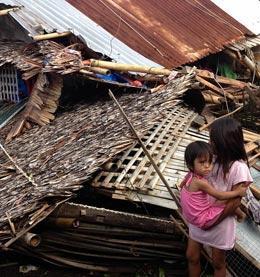Human traffickers prey on typhoon victims

After super typhoon Yolanda swept away her home in Guiuan, Eastern Samar, 14-year-old Noemi was forced to beg for food. Her family lost everything, and had nowhere to go.
So off she went to Tacloban with a relative to find work as a domestic helper. “I had nowhere to go and I didn’t know what to do except to beg at the jetty port in my hometown so I decided to go with my aunt.”
But Noemi ended up working as a waitress cum entertainer in a small sing-along bar on the fringes of Tacloban, which was also reeling from the impact of the powerful typhoon.
“My small salary has forced me to surrender to sexual propositions made by some customers in the bar,” she said.
Noemi’s story has become commonplace. Since Yolanda, also known by its international name Haiyan, hit Eastern Visayas in November last year, hundreds of boys and girls have reportedly been smuggled out of their hometowns to Tacloban, Cebu and even Manila by traffickers out to exploit the situation.
Yolanda, the strongest typhoon that ever hit the Philippines, slammed into several provinces in the Visayas and parts of Mindanao last November 8. Guiuan was one of the towns where it made landfall.
The typhoon killed more than 6,000 and affected up to 16 million people, many of them vulnerable to traffickers and other criminal syndicates.
Just before the Holy Week in April, five children aged 10 to 15, on board a passenger bus at the Tacloban New Bus Terminal in Abucay district, were rescued by police and social welfare officials.
They were from Marabut town in Samar and were accompanied by four adults who claimed to be non-government relief workers helping typhoon survivors in the province.
The Philippine National Police (PNP) in the region continues to receive reports of alleged trafficking of women and children in disaster-stricken areas in Leyte and Samar provinces.
Regional Director Chief Supt. Henry P. Losañes says families affected by Yolanda, especially women and children, remain vulnerable to human traffickers preying on their deplorable conditions. He says it is not easy to track cases of trafficking because they are difficult to identify and complaints and reports of this type of offense seldom come by.
“Six months after Yolanda, we continue to call on the public to report to authorities suspected cases of human trafficking,” Losañes said.
Right after the typhoon struck in November 2013, the police established Police Assistance Centers (PACs) at the Daniel Z. Romualdez Airport in Tacloban, in major seaports and in evacuation centers to assist and investigate suspected trafficking-in-person (TIP) cases.
Aid groups operating in Eastern Visayas are equally concerned about the reported human trafficking in the region.
Val C. Estevez, program manager of Save the Children, a US-based independent charity for children in need, said the government should strengthen its investigation into the suspected recruitment of child workers for sex trafficking.
“In areas affected by natural disasters, the risks for children to be trafficked are high. They are desperate and especially vulnerable to traffickers,” he added.
Another aid group, Plan International Philippines, confirmed that after typhoon Yolanda, cases of human trafficking were reported in three Samar provinces, adding that Samar Island is known as a source and transit area of human trafficking.
This story is part of VERA Files’ project Human Trafficking Casewatch supported by the U.S. Embassy’s Small Grants Facility and Embassy of Canada. VERA Files is put out by veteran journalists taking a deeper look into current issues.
Leave a comment






